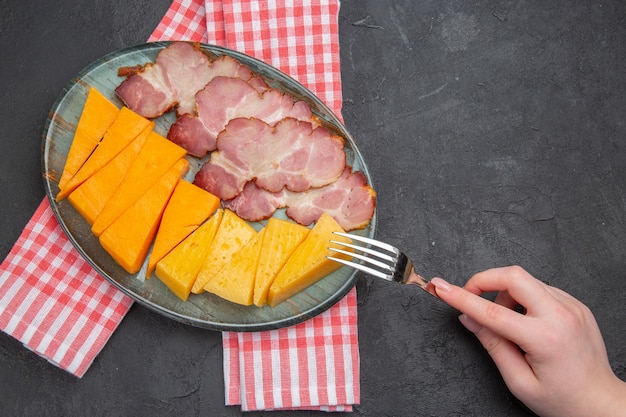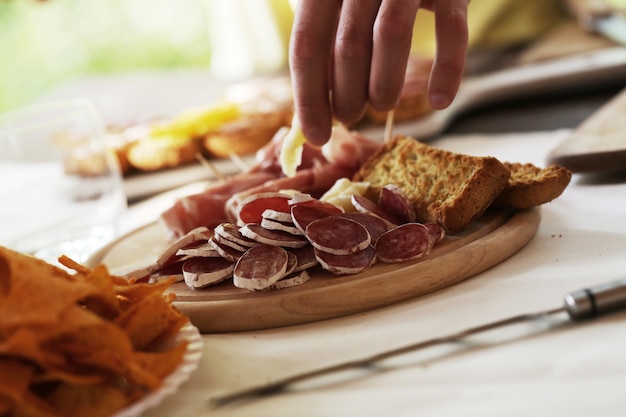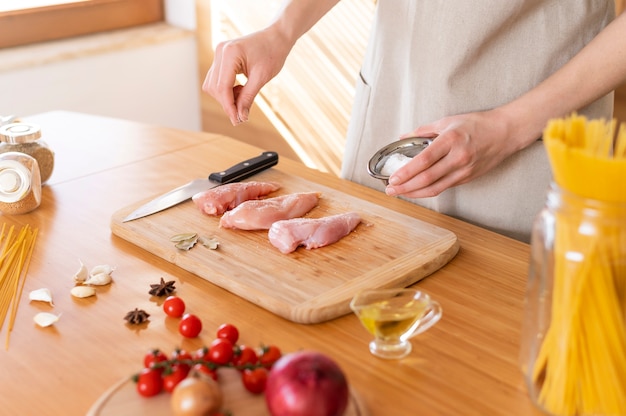(Part 1) The Great Ham Hunt: Choosing Your Perfect Cut

1. The Bone-In Bounty: A Classic Choice
Ah, the classic. It's got the bone, it's got the flavour, and it's generally the most affordable option. bone-in hams are fantastic for carving, providing a satisfyingly hefty centrepiece for your table. Plus, that bone? It adds a depth of flavour you just can't get with boneless hams.Now, there's a bit of a learning curve with bone-in hams. They need more space in the oven, can take a bit longer to cook, and you’ll need a decent carving knife and a firm hand to tackle the bone. But, trust me, it's worth the effort.
2. The Boneless Brave: Convenience at Your Fingertips
These guys are all about convenience. They’re pre-sliced, they’re easy to handle, and they often come in fun flavours like honey-glazed or maple-smoked. They also tend to cook a bit faster, which is a real bonus if you’re short on time.Now, they're not without their downsides. Boneless hams can be a bit dry if they're not cooked properly. You might also find they lack the same depth of flavour as their bone-in counterparts. Think of it as a trade-off: convenience for flavour.
3. The Spiral Seduction: A Showstopper for Any Table
Okay, these are the real showstoppers. spiral-sliced hams are a sight to behold, and they cook up a storm. The spiral cuts make for even cooking and they're perfect for carving into even slices. Plus, they usually come pre-glazed with delicious flavours.But here’s the catch: these beauties are often the most expensive option. They're also a bit more delicate, so you’ll want to handle them with care.
(Part 2) Sizing Up Your Ham: A Matter of Precision

1. The Weight Watchers: A Reliable Guide
The easiest way to determine size is by weight. Most hams are labelled with their weight, making it a straightforward measure. Just grab your kitchen scale and weigh that ham like you’re starring in a culinary detective show.Now, I know what you’re thinking: “Why can’t I just use the weight on the label?” You can, but I’ve learned the hard way that store scales can be fickle things. It’s always best to double-check.
2. The Ruler of the Ham: A Backup Solution
If you don’t have a scale, or if the ham is already in a baking dish, you can use a trusty ruler. Measure the length, width, and height of the ham. This will give you a rough estimate of its volume, which you can then use to calculate cooking times.Now, I’m not going to pretend this is as precise as weighing, but it’s a good backup option, especially if you’re already halfway through your cooking prep.
(Part 3) The Art of ham temperature: Unlocking the Perfect Bite

1. The Safe Zone: Ensuring food safety
The USDA recommends cooking ham to an internal temperature of 145°F (63°C). That’s the safe zone, the point at which all those pesky bacteria are zapped. But hold your horses, we’re not stopping there!We want to cook the ham until it’s truly delicious, not just safe. And that means reaching a higher temperature, a temperature that unlocks the ham’s full potential.
2. The Golden Triangle: 150°F – 160°F (66°C - 71°C)
This is the magic range for perfectly cooked ham. It ensures the ham is fully cooked while still retaining its juicy goodness. The exact temperature within this range depends on your personal preference.I like to aim for 155°F (68°C) for a moist and tender ham. But if you prefer a slightly firmer texture, you can go for 160°F (71°C). It’s all about finding your sweet spot.
(Part 4) The Cooking Chronicles: Oven, Stovetop, or slow cooker?
Now that you know what you’re looking for, it’s time to choose your method. Oven, stovetop, slow cooker, the options are endless!1. The Oven Bake: Classic and Reliable
The oven is a true ham-cooking workhorse. It provides even heat distribution, perfect for a well-cooked ham. You can bake your ham directly in a baking dish or even on a roasting rack, which allows for air circulation and prevents the ham from sitting in its own juices.The oven also offers versatility. You can add a glaze, baste with delicious sauces, and even roast vegetables alongside the ham for a complete meal.
2. The Stovetop Simmer: A Gentle Touch for Tender Ham
For a more hands-on approach, you can cook your ham on the stovetop. This method involves simmering the ham in a large pot of water, broth, or even wine. The simmering process tenderizes the ham and infuses it with flavour.Be careful, though. Stovetop cooking requires a bit more attention, as you’ll need to keep an eye on the water level and prevent it from boiling over.
3. The Slow Cooker Symphony: Convenience at Its Finest
For ultimate convenience, the slow cooker is your best friend. Pop your ham in the slow cooker, add some liquid, and let it cook away while you go about your day. The slow cooker’s gentle heat breaks down the tough connective tissue, resulting in a tender and flavorful ham.And the best part? No need to monitor it every minute! Just set it and forget it.
(Part 5) Cooking Time: A Calculated Approach to Success
Alright, here’s where things get a bit technical. Calculating the cooking time for your ham depends on its size, whether it’s bone-in or boneless, and even the type of oven you have.But don’t panic, I’ve got you covered. We’re going to break this down into manageable steps.
1. The Basic Formula: A Starting Point for Cooking Times
Here's a simple formula to get you started:
- Bone-in hams: 20-25 minutes per pound (4.5kg - 5.5kg)
- Boneless hams: 15-20 minutes per pound (4.5kg - 5.5kg)
Remember, this is just a starting point. You'll want to adjust the cooking time based on the ham's size and your oven.
2. The Oven Adjustment: Considering Your Cooking Appliance
- Conventional Ovens: Stick to the basic formula.
- Convection Ovens: Reduce the cooking time by 15-20%.
3. The Size Factor: Adjusting for Larger Hams
The larger the ham, the longer it will take to cook. For hams over 10 pounds (4.5kg), you might need to add an extra 30-45 minutes to the cooking time.
4. The Temperature Check: Using a meat thermometer
Remember, the internal temperature is king. Use a meat thermometer to check the ham's temperature in the thickest part. Once it reaches 150°F - 160°F (66°C - 71°C), you're ready to serve.
(Part 6) The Glazing Game: Sweeten Up Your Ham
Now, we’re talking about turning that ham into a real star. A good glaze adds a touch of sweetness, a burst of flavour, and a beautiful shine.1. The Classics: Tried-and-True Glazes
Here are a few tried-and-true glazes that will never let you down:
- brown sugar glaze: A simple mixture of brown sugar, mustard, and a touch of vinegar. This glaze is sweet, tangy, and perfectly balanced.
- honey mustard glaze: A classic combination of honey and mustard, with a touch of garlic and paprika for extra flavour.
- Maple Syrup Glaze: Rich and decadent, maple syrup glaze brings out the natural sweetness of the ham.
2. The Adventurous: Unique Glazes for Bold Flavours
If you’re feeling bold, try these more unique glazes:
- pineapple glaze: Sweet and tangy, with a tropical twist. It’s a perfect glaze for ham cooked with pineapple chunks.
- cherry glaze: Rich and fruity, with a touch of sweetness and a hint of tartness. It pairs well with ham cooked with cherry preserves.
- Ginger Glaze: A spicy and aromatic glaze with a touch of heat. It’s perfect for those who like a bit of a kick.
(Part 7) The Ham's Afterlife: Leftover Love
Let’s be honest, there’s almost always leftover ham. But don’t fret, leftover ham is a culinary treasure waiting to be discovered!1. The Classics: Classic Leftover ham recipes
Here are some tried-and-true ways to use up those leftover slices:
- ham sandwiches: A classic for a reason. Pair the ham with your favourite cheese, bread, and condiments.
- ham and cheese quiche: A delicious and satisfying way to use up leftover ham. Add a touch of cream, cheese, and vegetables for a hearty meal.
- ham soup: A comforting and warming soup made with ham bones, vegetables, and a touch of cream.
2. The Creative: Unique and Delicious leftover ham recipes
Let’s get adventurous with those leftover ham slices:
- Ham and Broccoli fried rice: A delicious and flavorful way to use up leftover ham, rice, and broccoli. Add a touch of soy sauce, garlic, and ginger for extra flavour.
- Ham and Potato Hash: A hearty and filling breakfast or brunch dish. Add a touch of onion, pepper, and a fried egg for a complete meal.
- ham pizza: A unique and delicious pizza topping. Combine ham with your favourite pizza toppings for a flavorful twist.
(Part 8) Ham Cooking: FAQs
Alright, folks, I know you’ve got questions. Let’s tackle some common queries about cooking ham.1. Can I Cook a Ham From Frozen?
Absolutely! You can cook a ham straight from frozen. Just add an extra 30-45 minutes to the cooking time. Make sure the ham is fully thawed before serving.2. How Can I Prevent My Ham From Drying Out?
I know this is a common concern, but there are a few tricks to help you avoid that dry, rubbery texture.- Basting: Baste the ham regularly with juices, wine, or broth to keep it moist.
- water bath: Place a pan of water in the bottom of your oven to create steam, which helps keep the ham moist.
- Cover It Up: Cover the ham with foil for the first part of the cooking time. This will help it retain moisture.
3. What If My Ham Is Overcooked?
Don’t worry, it’s not the end of the world. An overcooked ham will still be safe to eat, it’ll just be a little drier. You can try slicing it thinly and serving it with a sauce or dressing to help make it more palatable.4. Can I Reheat a Ham?
Yes, you can! Reheat it in the oven or microwave. Just make sure it reaches an internal temperature of 145°F (63°C).5. Should I Cook a pre-cooked ham?
While pre-cooked hams are safe to eat without further cooking, I recommend heating them gently to enhance their flavour and texture. Just bake them in the oven at 325°F (160°C) for about 15-20 minutes.(Part 9) The Ham’s Final Curtain Call: Serving with Style
Alright, your ham is cooked to perfection, it’s glazed to glory, and you’ve got a feast of delicious leftovers. Now, let’s talk about the grand finale: serving your ham with style.1. The Carving Ceremony: A Masterclass in Presentation
Carving a ham can seem daunting, but with a few simple tips, it’s a breeze.
- Use a Sharp Knife: A sharp carving knife is essential for clean cuts. Don’t try to force it, let the knife glide through the ham.
- Start at the Bone: For bone-in hams, start at the bone and work your way outwards, carving slices in a circular motion.
- Keep it Straight: For boneless hams, slice the ham straight across, making sure each slice is about ??-inch (0.6cm) thick.
2. The Sidekick Symphony: Choosing the Perfect Accompaniments
No ham is complete without a fabulous sidekick. Here are a few ideas to elevate your ham feast:
- sweet potatoes: A classic pairing for ham, offering a sweet and savory contrast.
- green beans: A light and refreshing side dish that cuts through the richness of the ham.
- Cornbread: A Southern staple that pairs perfectly with the savory flavours of ham.
- Roasted Vegetables: A colourful and flavourful option that complements the ham beautifully.
- fruit salad: A refreshing and tangy addition to balance the richness of the ham.
3. The Presentation Play: Creating a Showstopping Display
Don’t underestimate the power of presentation. A beautifully plated ham can make a meal feel extra special.
- Carving Station: Set up a carving station with a cutting board, serving platter, and carving utensils.
- Garnish: Add a touch of elegance with fresh herbs, fruit slices, or even a sprig of rosemary.
- Presentation Platter: Choose a platter that complements the colour and style of your ham.
- Buffet Style: Create a buffet-style spread with various side dishes, salads, and accompaniments.
(Part 10) The Ham’s Legacy: A culinary adventure
And there you have it, folks, the ultimate guide to cooking perfect ham. It’s a journey that takes you from the supermarket aisle to your dinner table, a journey filled with flavour, tradition, and, of course, a touch of culinary magic.Remember, cooking a ham is about more than just following a recipe. It’s about creating memories, sharing a meal with loved ones, and celebrating the simple pleasures of good food.
So, go forth, friends, and cook up a storm. May your ham be tender, your glaze be sweet, and your dinner table be filled with laughter and good cheer.
Everyone is watching

Corn on the Cob: The Ultimate Guide to Perfectly Cooked Ears
Healthy MealsAh, corn on the cob. Just the name evokes images of sunny days, barbecues, and that sweet, juicy flavour that ...

Perfect Pork Roast Oven Cooking Time: A Guide to Delicious Results
Healthy MealsThere's something truly satisfying about a perfectly roasted pork. The aroma alone is enough to make your mout...

Ham Cooking Time: How Long to Bake, Smoke, or Boil a Delicious Ham
Healthy MealsAh, ham. It's a classic, isn't it? A real crowd-pleaser, especially around holidays. And when done right, it'...

Scallops: The Ultimate Guide to Perfect Cooking
Healthy MealsAh, scallops. Those delicate, sweet, and utterly delicious morsels of the sea. They hold a special place in my...

Spaghetti Squash: The Ultimate Guide to Cooking and Serving
Healthy MealsRemember that time you saw spaghetti squash at the supermarket, looking all bumpy and strange, and thought, "W...
